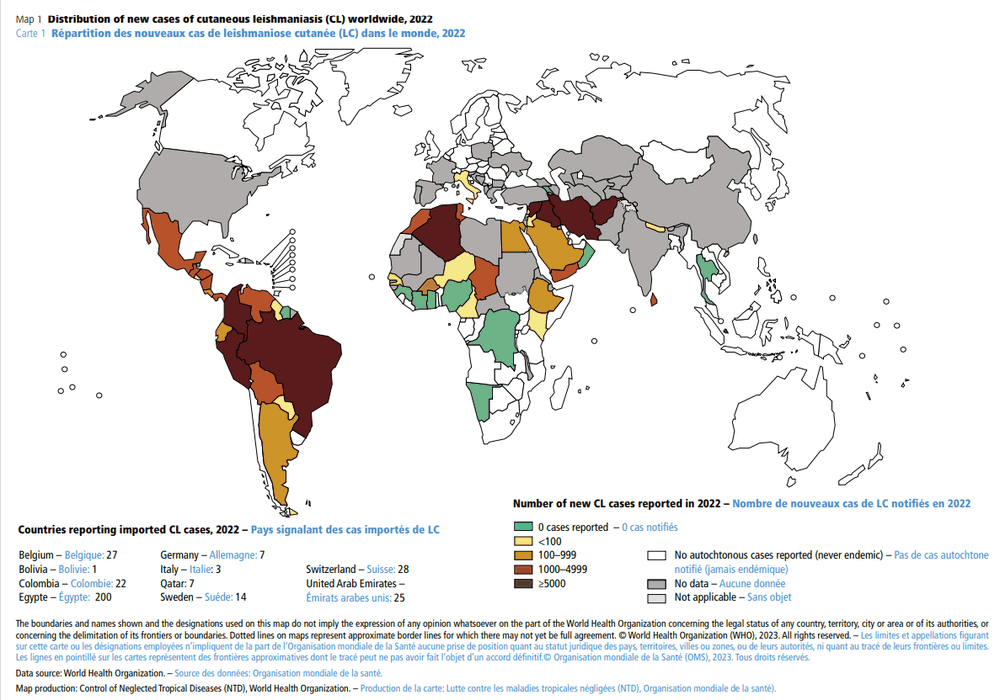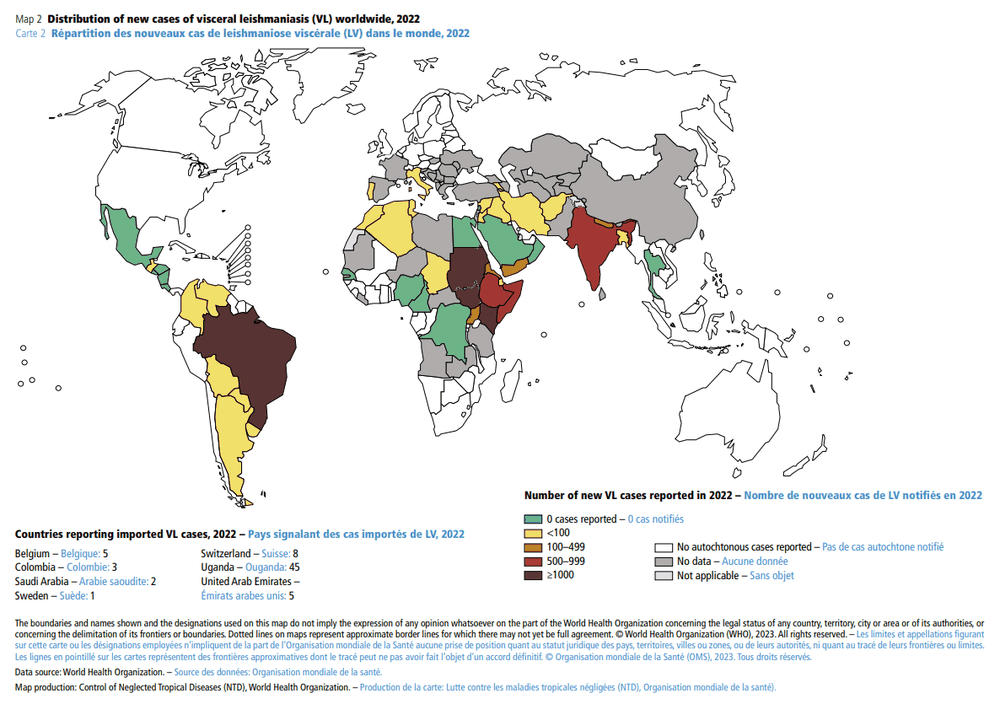Globally, an estimated 700,000 to one million new cases occur annually; 600,000 to one million new cases of cutaneous leishmaniasis, and 50,000 to 90,000 new cases of visceral leishmaniasis.[14]World Health Organization. Fact sheet: leishmaniasis. Jan 2023 [internet publication].
https://www.who.int/news-room/fact-sheets/detail/leishmaniasis
Leishmaniasis occurs in 99 countries or territories in the tropics and subtropics, including the southern US, southern Europe, and most of Central and South America. Fewer than 100 autochthonous cases have been reported in the US in the past 100 years.[15]National Institutes of Health, Centers for Disease Control and Prevention, HIV Medicine Association, and Infectious Diseases Society of America. Panel on Guidelines for the Prevention and Treatment of Opportunistic Infections in Adults and Adolescents with HIV. Guidelines for the prevention and treatment of opportunistic infections in adults and adolescents with HIV: Leishmaniasis. 2024 [internet publication].
https://clinicalinfo.hiv.gov/en/guidelines/hiv-clinical-guidelines-adult-and-adolescent-opportunistic-infections/leishmaniasis
Leishmaniasis is a major health problem in four regions:[16]World Health Organization. Global leishmaniasis surveillance updates 2023: 3 years of the NTD road map. 2024 [internet publication].
https://www.who.int/publications/i/item/who-wer-9945-653-669
Cutaneous leishmaniasis (CL)
CL is the most common leishmanial syndrome worldwide. In 2023, 272,098 new cases of CL (271,705 autochthonous and 393 imported) were reported globally. Cases have varied from as few as 185,454 in 2014 to the highest peak of 280,679 in 2019. The number of cases dropped during the COVID-19 pandemic, with levels approaching pre-COVID-19 levels again in 2023.[16]World Health Organization. Global leishmaniasis surveillance updates 2023: 3 years of the NTD road map. 2024 [internet publication].
https://www.who.int/publications/i/item/who-wer-9945-653-669
Ninety countries are endemic for CL. The majority of cases were reported from the Eastern Mediterranean region (81%) and the region of the Americas (13%). The two epidemiological hotspots were the Eastern Mediterranean region and Algeria.
Eleven countries represented 91% of CL cases: Afghanistan; Algeria; Brazil; Colombia; Iran (Islamic Republic of); Iraq; Pakistan; Peru; Sri Lanka; Syrian Arab Republic; and Yemen.
Most cases occurred in females (56%) and children aged <5 years (51%).
The global number of cases has been increasing, due to the adaptation of transmission cycles to peridomestic environments; the spread to previously non-endemic areas due to urbanisation and deforestation; limited or non-existent vector or reservoir control programmes; improved diagnosis and case notification; increased detection of leishmaniasis associated with opportunistic infections (e.g., HIV infection); and the emergence of antileishmanial drug resistance.[17]Alvar J, Aparicio P, Aseffa A, et al. The relationship between leishmaniasis and AIDS: the second 10 years. Clin Microbiol Rev. 2008 Apr;21(2):334-59.
https://journals.asm.org/doi/10.1128/CMR.00061-07?url_ver=Z39.88-2003
http://www.ncbi.nlm.nih.gov/pubmed/18400800?tool=bestpractice.com
[18]Croft SL, Sundar S, Fairlamb AH. Drug resistance in leishmaniasis. Clin Microbiol Rev. 2006 Jan;19(1):111-26.
http://cmr.asm.org/content/19/1/111.full
http://www.ncbi.nlm.nih.gov/pubmed/16418526?tool=bestpractice.com
CL is the form that is most likely to be seen in the US. It has been reported in increasing numbers in the US and UK, most likely due to increased travel to endemic areas as a result of tourism, military duty, or professional work.[19]Wright NA, Davis LE, Aftergut KS, et al. Cutaneous leishmaniasis in Texas: A northern spread of endemic areas. J Am Acad Dermatol. 2008 Apr;58(4):650-2.
http://www.ncbi.nlm.nih.gov/pubmed/18249464?tool=bestpractice.com
[20]Blum J, Desjeux P, Schwartz E, et al. Treatment of cutaneous leishmaniasis among travellers. J Antimicrob Chemother. 2004 Feb;53(2):158-66.
https://academic.oup.com/jac/article/53/2/158/850588
http://www.ncbi.nlm.nih.gov/pubmed/14729756?tool=bestpractice.com
[21]Lawn SD, Whetham J, Chiodini PL, et al. New world mucosal and cutaneous leishmaniasis: an emerging health problem among British travellers. QJM. 2004 Dec;97(12):781-8.
http://www.ncbi.nlm.nih.gov/pubmed/15569809?tool=bestpractice.com
[22]Weina PJ, Neafie RC, Wortmann G, et al. Old world leishmaniasis: an emerging infection among deployed US military and civilian workers. Clin Infect Dis. 2004 Dec 1;39(11):1674-80.
https://academic.oup.com/cid/article/39/11/1674/465860
http://www.ncbi.nlm.nih.gov/pubmed/15578370?tool=bestpractice.com
Large outbreaks (i.e., >200,000 cases) have been associated with sustained periods of conflict and the resulting collapse of health services (e.g., Afghanistan, Syria).[23]Alvar J, Vélez ID, Bern C, et al; WHO Leishmaniasis Control Team. Leishmaniasis worldwide and global estimates of its incidence. PLoS One. 2012;7(5):e35671.
https://journals.plos.org/plosone/article?id=10.1371/journal.pone.0035671
http://www.ncbi.nlm.nih.gov/pubmed/22693548?tool=bestpractice.com
[Figure caption and citation for the preceding image starts]: Distribution of new cases of cutaneous leishmaniasis (CL) worldwide, 2022WHO https://www.who.int/publications/i/item/who-wer9840-471-487; used with permission [Citation ends].
Visceral leishmaniasis (VL)
VL is the most serious form of the disease and is fatal in most cases if left untreated. In 2023, 11,922 new cases of VL (11,762 autochthonous and 160 imported) were reported globally. The number of cases reported has decreased by 62% overall since 2014.[16]World Health Organization. Global leishmaniasis surveillance updates 2023: 3 years of the NTD road map. 2024 [internet publication].
https://www.who.int/publications/i/item/who-wer-9945-653-669
Eighty countries are endemic for VL. The majority of cases were reported from the Eastern Mediterranean region (42%) and the African region (37%). The three epidemiological hotspots were East Africa, Brazil, and the Indian subcontinent.
Four countries represented 60% of cases: Brazil; Ethiopia; Kenya; and Sudan. Most cases occurred in males (62%) and people aged ≥15 years (50%).
In the US, symptomatic VL is a rare disease found in returning US military service members from Iraq or Afghanistan, or in migrants or visitors from endemic areas.[24]Myles O, Wortmann GW, Cummings JF, et al. Visceral leishmaniasis: clinical observations in 4 US army soldiers deployed to Afghanistan or Iraq, 2002-2004. Arch Intern Med. 2007 Sep 24;167(17):1899-901.
http://www.ncbi.nlm.nih.gov/pubmed/17893312?tool=bestpractice.com
[25]Wortmann G, Miller RS, Oster C, et al. A randomized, double-blind study of the efficacy of a 10- or 20-day course of sodium stibogluconate for treatment of cutaneous leishmaniasis in United States military personnel. Clin Infect Dis. 2002 Aug 1;35(3):261-7.
http://cid.oxfordjournals.org/content/35/3/261.full
http://www.ncbi.nlm.nih.gov/pubmed/12115091?tool=bestpractice.com
[26]Stahlman S, Williams VF, Taubman SB. Incident diagnoses of leishmaniasis, active and reserve components, U.S. Armed Forces, 2001-2016. MSMR. 2017 Feb;24(2):2-7.
http://www.ncbi.nlm.nih.gov/pubmed/28234494?tool=bestpractice.com
However, surveillance for asymptomatic Leishmania infantum (synonym: Leishmania chagasi) infection among Iraq-deployed US service members identified a 19.5% infection rate.[27]Mody RM, Lakhal-Naouar I, Sherwood JE, et al. Asymptomatic visceral Leishmania infantum infection in US soldiers deployed to Iraq. Clin Infect Dis. 2019 May 30;68(12):2036-44.
https://www.ncbi.nlm.nih.gov/pmc/articles/PMC6769235
http://www.ncbi.nlm.nih.gov/pubmed/30239631?tool=bestpractice.com
Foxhounds have been found to be infected by L infantum in eastern states, but autochthonous transmission to humans has yet to be described in the US.[28]Duprey ZH, Steurer FJ, Rooney JA, et al. Canine visceral leishmaniasis, United States and Canada, 2000-2003. Emerg Infect Dis. 2006 Mar;12(3):440-6.
http://wwwnc.cdc.gov/eid/article/12/3/05-0811_article.htm
http://www.ncbi.nlm.nih.gov/pubmed/16704782?tool=bestpractice.com
VL mainly affects resource-poor people in rural areas in endemic countries. However, several reports have documented its expansion into urban areas (e.g., Brazil).[29]Alvar J, Yactayo S, Bern C. Leishmaniasis and poverty. Trends Parasitol. 2006 Dec;22(12):552-7.
http://www.ncbi.nlm.nih.gov/pubmed/17023215?tool=bestpractice.com
VL has been eliminated in Bangladesh, and it is the first country in the world to be validated for eliminating it as a public health problem.[30]World Health Organization. Bangladesh achieves historic milestone by eliminating kala-azar as a public health problem. 2023 [internet publication].
https://www.who.int/news/item/31-10-2023-bangladesh-achieves-historic-milestone-by-eliminating-kala-azar-as-a-public-health-problem
[Figure caption and citation for the preceding image starts]: Distribution of new cases of visceral leishmaniasis (VL) worldwide, 2022WHO https://www.who.int/publications/i/item/who-wer9840-471-487; used with permission [Citation ends].
Post-kala-azar dermal leishmaniasis
In 2023, 483 new cases of post-kala-azar dermal leishmaniasis were reported globally from seven countries, with 67% of cases reported from India.[16]World Health Organization. Global leishmaniasis surveillance updates 2023: 3 years of the NTD road map. 2024 [internet publication].
https://www.who.int/publications/i/item/who-wer-9945-653-669
Co-infection with leishmaniasis (predominantly VL) and HIV has been reported in at least 42 countries.[15]National Institutes of Health, Centers for Disease Control and Prevention, HIV Medicine Association, and Infectious Diseases Society of America. Panel on Guidelines for the Prevention and Treatment of Opportunistic Infections in Adults and Adolescents with HIV. Guidelines for the prevention and treatment of opportunistic infections in adults and adolescents with HIV: Leishmaniasis. 2024 [internet publication].
https://clinicalinfo.hiv.gov/en/guidelines/hiv-clinical-guidelines-adult-and-adolescent-opportunistic-infections/leishmaniasis
[16]World Health Organization. Global leishmaniasis surveillance updates 2023: 3 years of the NTD road map. 2024 [internet publication].
https://www.who.int/publications/i/item/who-wer-9945-653-669
In the period 2014-2023, 3902 cases of VL-HIV co-infection were reported.
The introduction of antiretroviral therapy has caused the incidence to decrease substantially in developed countries, but co-infection with HIV is growing in parts of Asia, Latin America, and Africa.
WHO: leishmaniasis country profile
Opens in new window

